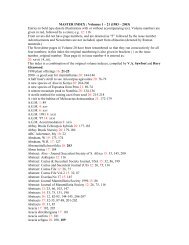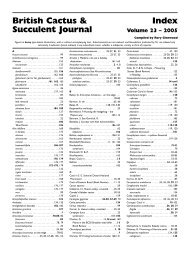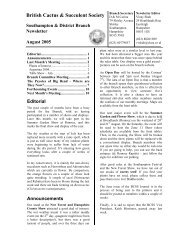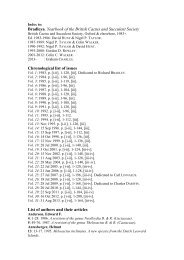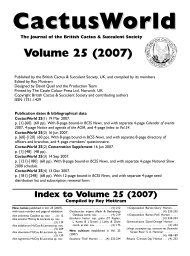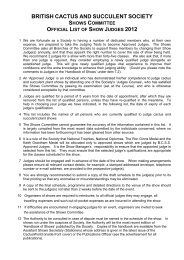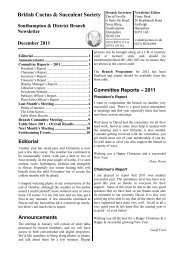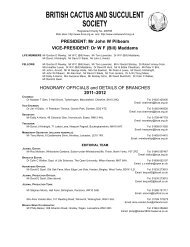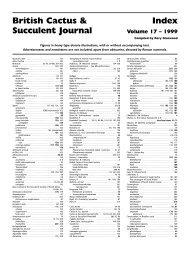British Cactus & Succulent Society - southampton.bcss.org.uk
British Cactus & Succulent Society - southampton.bcss.org.uk
British Cactus & Succulent Society - southampton.bcss.org.uk
You also want an ePaper? Increase the reach of your titles
YUMPU automatically turns print PDFs into web optimized ePapers that Google loves.
BCSS Southampton & District Branch – May 2005 Newsletter Page 3less common such as pygmaea (var. ‘Frosty Top’is nice) and springbokvlakensis (remaining small)and bruynsii. (The latter is still rare in collections– perhaps due to its high price, difficulty ofpropagation and slow growth; most plants offeredrecently are most likely to have beenmicropropagated.) Last in the group is tesselata, agood grower – there are some good small clonesand the cv. ‘Lady Gray’ is recommended.On to the ‘hard’ leaved ones. coarctata (esp. asmall form var. bellula) and reinwardtii arecommon, but some forms are difficult. Someplants of this group develop ‘stems’ which aresometimes spoilt by leaves part way up dyingback. Stirling said that the cause of this isunknown. Many of this group develop prettytubercles, often white and pearlescent, giving riseto good markings. One of the potentially tallestspecies is pumila, but minima belies its name andis certainly nowhere near being the smallestHaworthia. For minima, the var. ‘Bryan Makin’is a fine form. Slow and more choice are sordidaand its var. lavrani (possibly the same as sordidavar. agavoides) and scabra, but scabra var.morrisiae is easier.Haworthia is a genus that lends itself tohybridisation, but Stirling warned against any oldhybrid – they must have some merit to be retainedas many are not worth growing. Joyce Coccoza isamong those who produce many attractivehybrids, in addition to her excellent drawings ofHaworthias. The Japanese also produce manyfancy varieties. Many such crosses were shown:for example maughnii x badia (a good showplant), arachnoidea x truncata, (severalvariations) and herbacea x emelyae, perhaps thebest known of Joyce’s crosses.At the start of the second half, which was a slideprogramme, Stirling showed variegated forms ofmany of the species discussed earlier. [magnifica,venosa (unstable), limifolia (stable), cymbiformis,retusa, viscosa and maughnii. Here Stirlingsneaked in Gasteraloe x ‘Green Ice’, a veryattractive plant with possibly a variegatedGasteria batesiana somewhere in its lineage. Thefeeling here is that one either likes them or hatesthem! Some further hybrids were shown here,repeating some we had seen as plants in the firsthalf, plus pygmaea x paradoxa (often differentnames, same cross), comptoniana xspringbokvlakensis (reasonably quick growing),limifolia x striata (not easy) and correcta xspringbokvlakensis.Returning to ‘pure’ plants we heard that badia,with thick leaves, is difficult to get to ‘sit’ on thecompost, a miniature form of coarctata, one ofthe smallest rosettes with parksiana (slow, can bedifficult), pubescens (nice), habdomadis var.inconfluens keeps a tight rosette, maraisii (nowunder magnifica) and the lockwoodii trio referredto in the first half, and schuldtiana. Nice veiningis possible on correcta (although this tends to loseleaves and often pulls itself down into the soil).At this point Stirling gave the Haworthias a restwhen he showed a few slides of some othersucculents, the most exciting of which wasMuiria, followed by some Anacampseros andAvonia, Ariocarpus, Brachystelma, a Lithops anda lovely Crassula mesembryanthemopsis.Back to the evening’s main topic. We moved onto splendens x badia crosses, small plants, severalclones, will colour up well in good light but keepthe roots cool. Next, koelmaniorum and some ofits hybrids, pulchella var. globifera(?), semiviva(small and variable), mcmurtryi (some consider avar. of koelmaniorum), tesselata (various patterns,some good, some named) and others seen earlieras plants.Postscript 1. Hobbyists new to Haworthias neednot fret too much about identifying their plants.Although the taxonomy of Haworthia is thesubject of often acrimonious debate, it is mainlythe retusae types which cause problems; probablya good 60% of the species are fairly readilyidentifiable in the newer books, e.g. Bayer’s‘Haworthia Revisited’.Postscript 2. I apologise for breaking my ownrule that the scribe should not write a blow-byblowaccount of a talk. Perhaps that’s because Iam a Haworthia enthusiast! You have the optionto skip the ‘heavy’ bits. And I leave the flowerson my plants, although this is more throughlaziness than intention (unless I’m trying forseed).David Corina




